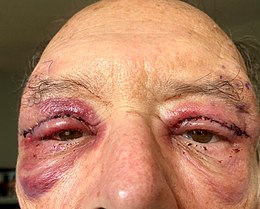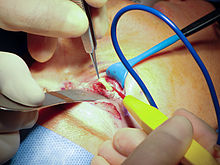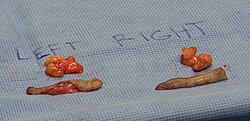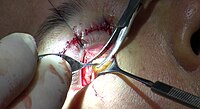
Plastic surgery is a surgical specialty involving the restoration, reconstruction, or alteration of the human body. It can be divided into two main categories: reconstructive surgery and cosmetic surgery. Reconstructive surgery includes craniofacial surgery, hand surgery, microsurgery, and the treatment of burns. While reconstructive surgery aims to reconstruct a part of the body or improve its functioning, cosmetic surgery aims to improve the appearance of it. A comprehensive definition of plastic surgery has never been established, because it has no distinct anatomical object and thus overlaps with practically all other surgical specialties. An essential feature of plastic surgery is that it involves the treatment of conditions that require or may require tissue relocation skills.

Rhinoplasty, commonly called nose job, medically called nasal reconstruction, is a plastic surgery procedure for altering and reconstructing the nose. There are two types of plastic surgery used – reconstructive surgery that restores the form and functions of the nose and cosmetic surgery that changes the appearance of the nose. Reconstructive surgery seeks to resolve nasal injuries caused by various traumas including blunt, and penetrating trauma and trauma caused by blast injury. Reconstructive surgery can also treat birth defects, breathing problems, and failed primary rhinoplasties. Rhinoplasty may remove a bump, narrow nostril width, change the angle between the nose and the mouth, or address injuries, birth defects, or other problems that affect breathing, such as a deviated nasal septum or a sinus condition. Surgery only on the septum is called a septoplasty.
Facial feminization surgery (FFS) is a set of reconstructive surgical procedures that alter typically male facial features to bring them closer in shape and size to typical female facial features. FFS can include various bony and soft tissue procedures such as brow lift, rhinoplasty, cheek implantation, and lip augmentation.

Eye surgery, also known as ophthalmic surgery or ocular surgery, is surgery performed on the eye or its adnexa. Eye surgery is part of ophthalmology and is performed by an ophthalmologist or eye surgeon. The eye is a fragile organ, and requires due care before, during, and after a surgical procedure to minimize or prevent further damage. An eye surgeon is responsible for selecting the appropriate surgical procedure for the patient, and for taking the necessary safety precautions. Mentions of eye surgery can be found in several ancient texts dating back as early as 1800 BC, with cataract treatment starting in the fifth century BC. It continues to be a widely practiced class of surgery, with various techniques having been developed for treating eye problems.
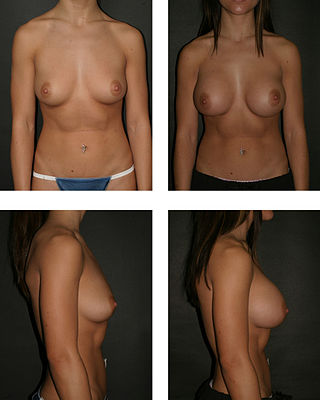
Breast augmentation and augmentation mammoplasty is a cosmetic surgery technique using breast-implants and fat-graft mammoplasty techniques to increase the size, change the shape, and alter the texture of the breasts. Although in some cases augementation mammoplasty is applied to correct congenital defects of the breasts and the chest wall in other cases it is used purely as a cosmetic surgery, primary breast augmentation changes the aesthetics – of size, shape, and texture – of healthy breasts.

Reduction mammoplasty is the plastic surgery procedure for reducing the size of large breasts. In a breast reduction surgery for re-establishing a functional bust that is proportionate to the patient's body, the critical corrective consideration is the tissue viability of the nipple–areola complex (NAC), to ensure the functional sensitivity and lactational capability of the breasts. The indications for breast reduction surgery are three-fold – physical, aesthetic, and psychological – the restoration of the bust, of the patient's self-image, and of the patient's mental health.

An eyelid is a thin fold of skin that covers and protects an eye. The levator palpebrae superioris muscle retracts the eyelid, exposing the cornea to the outside, giving vision. This can be either voluntarily or involuntarily. "Palpebral" means relating to the eyelids. Its key function is to regularly spread the tears and other secretions on the eye surface to keep it moist, since the cornea must be continuously moist. They keep the eyes from drying out when asleep. Moreover, the blink reflex protects the eye from foreign bodies. A set of specialized hairs known as lashes grow from the upper and lower eyelid margins to further protect the eye from dust and debris.
East Asian blepharoplasty, more commonly known as double eyelid surgery, is a cosmetic procedure that reshapes the skin around the eye to create a crease in an upper eyelid that naturally lacks one. This surgery is especially popular among individuals of East Asian descent, including those from Chinese, Japanese, and Korean backgrounds. The primary goal is to enhance the eyelid's appearance, making the eyes appear larger and, according to some cultural aesthetics, more attractive due to a 'wide eyed' and expressive appearance.

A facelift, technically known as a rhytidectomy, is a type of cosmetic surgery procedure intended to give a more youthful facial appearance. There are multiple surgical techniques and exercise routines. Surgery usually involves the removal of excess facial skin, with or without the tightening of underlying tissues, and the redraping of the skin on the patient's face and neck. Exercise routines tone underlying facial muscles without surgery. Surgical facelifts are effectively combined with eyelid surgery (blepharoplasty) and other facial procedures and are typically performed under general anesthesia or deep twilight sleep.
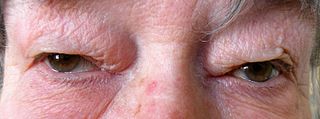
Dermatochalasis is a medical condition, defined as an excess of skin in the upper or lower eyelid, also known as "baggy eyes." It may be either an acquired or a congenital condition. It is generally treated with blepharoplasty.

Gluteoplasty denotes the plastic surgery and the liposuction procedures for the correction of congenital, traumatic, and acquired defects/deformities of the buttocks and the anatomy of the gluteal region; and for the aesthetic enhancement of the contour of the buttocks.
Facial rejuvenation is a cosmetic treatment, which aims to restore a youthful appearance to the human face. Facial rejuvenation can be achieved through either surgical and/or non-surgical options. Procedures can vary in invasiveness and depth of treatment. Surgical procedures can restore facial symmetry through targeted procedures and facial restructuring and skin alterations. Non-surgical procedures can target specific depths of facial structures and treat localized facial concerns such as wrinkles, skin laxity, hyperpigmentation and scars.
Mastopexy is the plastic surgery mammoplasty procedure for raising sagging breasts upon the chest of the woman, by changing and modifying the size, contour, and elevation of the breasts. In a breast-lift surgery to re-establish an aesthetically proportionate bust for the woman, the critical corrective consideration is the tissue viability of the nipple-areola complex (NAC), to ensure the functional sensitivity of the breasts for lactation and breast-feeding.
Oculoplastics, or oculoplastic surgery, includes a wide variety of surgical procedures that deal with the orbit, eyelids, tear ducts, and the face. It also deals with the reconstruction of the eye and associated structures.
A brachioplasty, commonly called an arm lift, is a surgical procedure to reshape and provide improved contour to the upper arms and connecting area of chest wall. Although "brachioplasty" is commonly used to describe a specific procedure for the upper arms, the term can also be used to describe any surgical arm contouring. Brachioplasty is often used to address issues such as excessive loose skin or excessive fat in the arms when it does not respond well to diet and exercise. Brachioplasty is a common procedure for patients who have experienced massive weight loss and has gained popularity since 2000.
A DIEP flap is type of breast reconstruction where blood vessels, fat, and skin from the lower belly are relocated to the chest to rebuild breasts after mastectomy. DIEP stands for the deep inferior epigastric perforator artery, which runs through the abdomen. This is a type of autologous reconstruction, meaning one's own tissue is used.

Liposuction, or simply lipo, is a type of fat-removal procedure used in plastic surgery. Evidence does not support an effect on weight beyond a couple of months and does not appear to affect obesity-related problems. In the United States, liposuction is the most common cosmetic surgery.
Aesthetic medicine is a branch of modern medicine that focuses on altering natural or acquired unwanted appearance through the treatment of conditions including scars, skin laxity, wrinkles, moles, liver spots, excess fat, cellulite, unwanted hair, skin discoloration, spider veins and or any unwanted externally visible appearance. Traditionally, it includes dermatology, oral and maxillofacial surgery, reconstructive surgery and plastic surgery, surgical procedures, non-surgical procedures, and a combination of both. Aesthetic medicine procedures are usually elective. There is a long history of aesthetic medicine procedures, dating back to many notable cases in the 19th century, though techniques have developed much since then.

A lip lift is the most common plastic surgery procedure that modifies the cosmetic appearance of the lips, by reshaping them to increase the prominence of the vermilion border and to enhance the facial area above the lips into a more aesthetically pleasing shape. In corrective praxis, a lip lift procedure is distinguished from lip enhancement, the augmentation of the lips, which can be affected with a non-surgical procedure.
Facial Autologous Muscular Injection is also known as Fat Autograft Muscular Injection, as Autologous Fat Injection, as Micro-lipoinjection, as Fat Transfer and as Facial Autologous Mesenchymal Integration, abbreviated as FAMI. The technique is a non-incisional pan-facial rejuvenation procedure using the patient's own stem cells from fat deposits. FAMI is an Adult stem cell procedure used to address the loss of volume in the face due to aging or surgery repair in restoring facial muscles, bone surfaces and very deep fat pads. The procedure involves removing adult stem cells of fatty tissue from lower body, and refining it to be able to re-inject living adipose stem cells into specific areas of the face without incision. FAMI is an outpatient procedure and an alternative to artificial fillers, blepharoplasty or various face lifts. The procedure does not require general anesthesia and risks of an allergic reaction are minimal due to the use of the patient's own tissue used as the facial injection.


